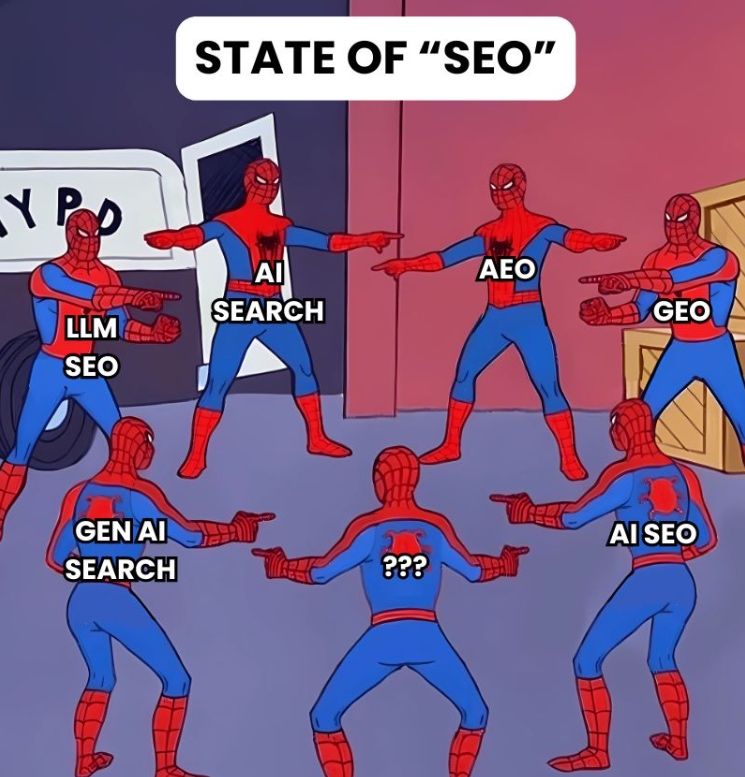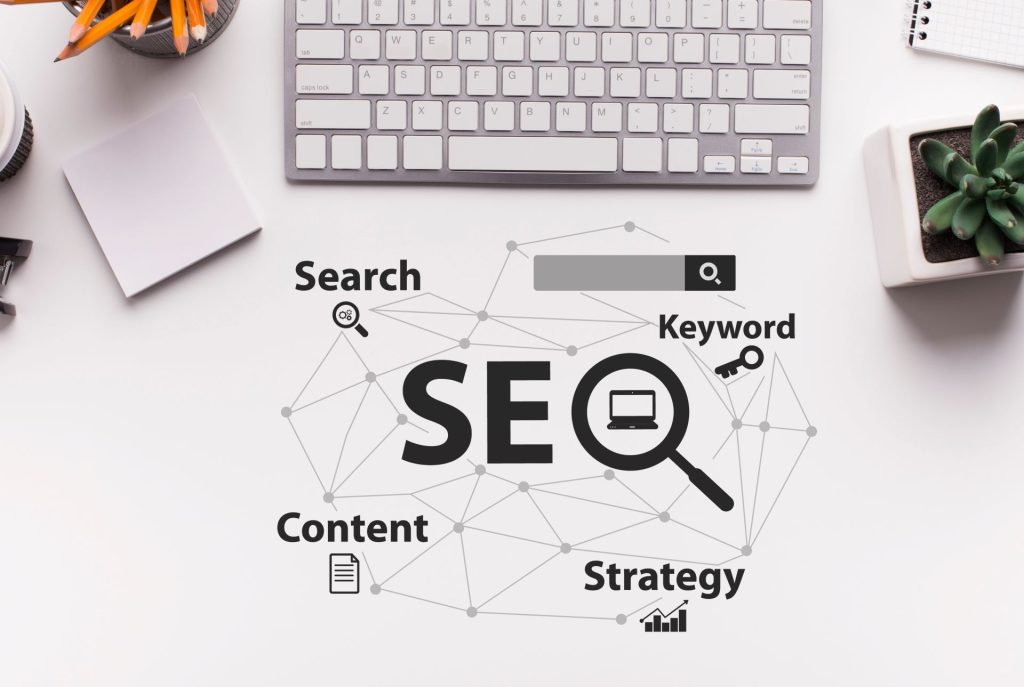Search Engine Optimization (SEO) isn’t enough to stay competitive in the digital world. Search technology has changed, and user behavior has evolved. Marketing, content strategy, SaaS, and business leaders need to develop a deeper understanding of SEO vs AEO to keep growing and maintain their rankings.
Beyond that, generative search engine optimization (GEO) and Large Language Model Optimization (LLMO) have changed the way search engines work.
These concepts and more are explored in this article, in addition to how search works and how to prepare your own content for AI search.

What Is Answer Engine Optimization (AEO)?
Answer Engine Optimization (AEO) is the new way of thinking about SEO.
AEO is the evolving strategy and approach that aims to make online content fit better with how search users actually search. One of the key AEO benefits is increased visibility in zero-click search results, allowing brands to capture attention even when users don’t click through to a website.
Key Features of AEO
- Featured Snippets: Quick answers at the top of a search page that are also called “position zero”. Featured snippets are the first thing users see on a results page. AEO for featured snippets means using formats that fit the snippet style for the answers the majority of users are searching for.
- People Also Ask (PAA): Pop-up question boxes for related questions that users may want answered. AEO means creating Q&A content that fits this format.
- Zero-Click Searches: Search answers often come at the top of the page or through featured snippets, reducing clicks to actual URLs. AEO is providing direct answers that rank at the top of search so that your brand is seen, even if not clicked.
- Voice Search: Voice queries are becoming more popular with the increase of home speakers, AI tools, and digital assistants. AEO is optimizing for natural language queries.
The Role of Schema Markup and Structured Data
Both schema markup and structured data are signals added to HTML code that explain content to search engines in a structured, machine-readable way. Schema markup and structured data in forms like FAQ schema, HowTo schema, and Product schema, among others, are an important way to tell AI-powered search engines where to find direct answers.
Benefits of AEO for Businesses
- Gain visibility in new and improved search features and elements
- Keep users on your page by answering their queries exactly
- Adapt to evolving search engine algorithms
SEO vs AEO – What’s the Real Difference?
SEO and AEO both deal with organic search and aim to improve visibility in search, but they have different strategies and focus areas. Unlike keyword-centric approaches, entity-based SEO leverages semantic relationships and concept recognition to improve how content is understood and surfaced by modern search engines.
Keyword Ranking vs Entity-Based Visibility
| Traditional SEO | AEO |
| Focus on specific keywords | Focus on entities and concepts |
| Emphasis on backlinks, keyword density, domain authority | Emphasis on user intent optimization and conversational queries |
| Optimizes structured, keyword-rich content for search engines | Optimizes conversational, natural language content for answer engines |
Content Style Differences
- SEO: Focus is on building content around keywords and search engine optimization around that.
- AEO: Content fits snippet-ready formats and is optimized for answer engines, with a focus on:
- Tables
- Lists
- FAQs or Q&A
Why SEO vs AEO Matters
SEO is the foundation of digital marketing. AEO is about overcoming current challenges with AI-powered search by building content that answers user queries in a conversational way, not the exact words users may use to query a search engine.
Introducing GEO and LLMO – The New Frontiers
Search is changing with new approaches and methods and there are two new terms to keep an eye on and understand.
What is Generative Engine Optimization (GEO)?
While AEO focuses on optimizing content for direct answers, GEO extends that goal by making content accessible to AI tools capable of generating synthesized responses. To support GEO strategies, brands should also explore technical enhancements like rapid URL indexing to boost local visibility and ensure that new or updated pages are discovered quickly by both traditional search engines and AI-driven systems.
Understanding the interplay between AEO vs GEO is essential for a truly future-proof strategy.
- GEO focuses on creating content optimized for generative AI engines like:
- ChatGPT
- Google Bard
- Other AI assistants
- These platforms generate original responses by synthesizing data from multiple sources.
- GEO complements AEO by creating material suitable for both direct user answers and AI-driven content summaries, reports, and overviews.
What is Large Language Model Optimization (LLMO)?
LLMO is the art and science of writing content with the intent of optimizing for large language models. Large language models are the tools and technologies that power AI writing assistants like ChatGPT, Google’s Gemini, or Microsoft Copilot.
Optimizing for large language models means structuring, designing, and writing content that you want to show up in and be usable in those tools. It means writing in a way that large language models will understand, interpret, and surface to other users. Optimizing for large language models also means often writing for people, which means focusing on clear writing, proper structure, creating and demonstrating authority, and other best practices.
- LLMO targets optimization for Large Language Models (LLMs) such as:
- OpenAI’s GPT series (GPT-3, GPT-4, etc.)
- Google’s Gemini
- These models require:
- Advanced natural language processing
- Contextually dense, semantically rich content
- LLMO works with GPT and Gemini and other LLMs to ensure they recognize your content as trustworthy and refer to it when users conduct searches.
Impact of AI Tools on Search
- Generative tools like ChatGPT, Google AI Overviews, Perplexity AI, and Microsoft’s Copilot give searchers original conversational responses.
- AI tools are also transforming the answers given for queries in search. Businesses need to use search engine optimization compatible with the new search and natural language processing (NLP) AI comprehension.

Building an OmniSEO Strategy That Works
To build a holistic strategy, OmniSEO is a concept that combines a multi-pronged approach with all facets of modern search to reach the largest audience.
What is OmniSEO?
OmniSEO integrates:
- Traditional SEO
- Answer Engine Optimization (AEO)
- Generative Engine Optimization (GEO)
Core Elements of OmniSEO
- Snippet-Friendly Content: Build FAQ lists, tables, and data that directly answers natural language queries in conversational language that search engines can recognize and link with search features that put these formats at the top of pages.
- Schema Markup: Add and use schema markup to support rich results and elements for direct answers and snippets.
- Conversational Language: Write and create content that answers queries with natural language. This is also part of voice search optimization.
- Authoritative, In-Depth Content: Balance needs for direct answers with in-depth, long-form content that shows expertise and authority.
Future-Proofing Content for AI-Driven Search
To rank highly in AI-driven ecosystems, your content must convey authority and trust signals through quality backlinks, expertise, and consistent branding. As AI continues to transform how content is discovered, companies that optimize for natural language queries and structured data will enjoy greater AI search visibility across emerging platforms.
There are four key areas of focus for creating content that is both present-ready and ready for the near future.
Key Focus Areas
- Authority and Trust: Brand awareness, backlinks, and other methods of building trust and demonstrating expertise.
- Knowledge Graph Optimization: Format and organize your content to align with Google’s knowledge graph. This is important for AI summaries and overviews.
- Google AI Overviews: The majority of AI-generated search summaries for search queries will be Google’s. Optimizing for these makes your content more visible.
- Long-Tail Keywords and Answer-First: Target long-tail keywords and focus on answer-first content that targets niche queries. This also helps optimize for the increasing trend of zero-click searches.

Why Adapting to AEO and GEO Matters Now
Digital search is moving on from SEO focused on keyword matches and the exact words users may use to query a search engine. Answer Engine Optimization (AEO), Generative Search Engine Optimization (GEO), and Large Language Model Optimization (LLMO) have joined SEO as the new digital marketing approaches to ensure your business remains visible and competitive.
To adapt your business now, you should:
- Develop an answer-first content strategy
- Invest in structured data and schema markup for search
- Write for conversational queries and optimize for voice search
SEO is the foundation, but SEO vs AEO and the concept of AEO show that things are changing and that businesses need to adapt to a new type of search that is no longer focused on text and key phrases.
If your business is ready to take the next step in your search strategy, contact WiRe Innovation today. And read this blog post to learn more about the SEO vs GEO debate.



